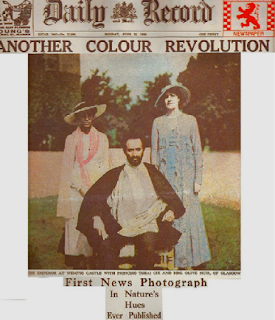A brief timeline of the history of print media:
17th century:
The first news bulletins/newspapers to start circulation. These were mostly handwritten until they began releasing printed periodicals which phased out handwritten newssheets.
1842:
The first newspaper to have illustrations was 'The Illustrated London News'. At the time of its release it was published weekly, and slowly phased out by 2003. These first ever newspaper illustrations were line drawings.
 |
| First illustrated newspapers with line drawings. |
1879:
The first photo to be published in a newspaper using halftones.
 |
| First published photo in a newspaper using halftones (rather than engraved image). 1879 "Steinway Hall" , (The Daily Graphic), NY. |
1880:
The first published newsphoto in a newspaper.
 |
| First published newsphoto, 1880, "Shanty Town" by Henry J. Newton (The Daily Graphic). |
1933:
Conflict between radio and newspapers breaks out. American newspapers attempt to force Associated Press to cease communication services to radio stations.
1936:
The first colour photo to be published in a newspaper.
 |
| First colour photo to be published. 1936, Scottish Daily Record & Mail. |
Also discussed was what makes a great photo?
A lot of these concepts I am already familiar with with my love all things Film and Television.
What makes a great photo?
- Framing
- Focus
- Angle & Point of View (POV)
- Exposure
- Shutterspeed
- Capturing 'the moment'
"A picture has no meaning at all if it can't tell a story."
The Rule of Thirds:
The theory is that if you place points of interest in the intersections or along the lines that your photo becomes more balanced and will enable a viewer of the image to interact with it more naturally. Studies have shown that when viewing images that people’s eyes usually go to one of the intersection points most naturally rather than the center of the shot – using the rule of thirds works with this natural way of viewing an image rather than working against it.
Read more: http://www.digital-photography-school.com/rule-of-thirds#ixzz1pn8niewZ
Two photos that I think utilise these ideas quite well are a couple of photos taken on the last day of year 12.
 |
| "Looking to the Future". Photo taken by Aliane Bylicki |
 |
| Rule of Thirds applied |
 |
| "Bubbles of Fun". Photo taken by Kate Dunstan |
 |
| Rule of thirds applied |
And of course, if there's a photo that's ever perfectly captured the moment, it is, of course, this end of war photograph shot by Alfred Eisenstaedt.
| "V-J Day in Times Square" |
So from the start of print media to the end, the perfect image will always be valuable. Do you have one?
"If it makes you laugh, if it makes you cry, if it rips out your heart, that's a good picture." Eddie Adams.
No comments:
Post a Comment